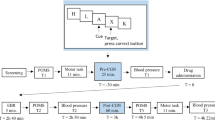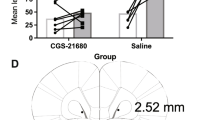Abstract
Rationale
It is well established that humans and rats respond to an imperative stimulus more rapidly as a function of the foreperiod preceding the target, and with this decrease in mean response time, there is also an increase in anticipatory (prior to the signal) responses. These changes reflect enhanced motor readiness. Also, reaction times are quicker when the cost of reward (amount of work required) is minimum. Antagonism of the adenosine A2A receptor has been shown to effect motor-related processes.
Objective
This study examined the behavioural effects of systemic administration of the adenosine A2A antagonist KW-6002 in a cued reaction time task in the rat. The purpose of this study is to ascertain whether KW-6002 would enhance motor readiness and effect performance as a function of reward cost.
Methods
Rats were trained on a visually cued reaction time task with variable foreperiods, and the effects of three doses of KW-6002 (0.3, 1.0 and 3.0 mg/kg systemically, compared to vehicle) were examined.
Results
Increasing doses of KW-6002 resulted in faster reaction times and an increase in the number of anticipatory responses. KW-6002 enhanced the foreperiod effect on reaction time distributions and anticipatory responses. In addition, KW-6002 had differential effects on performance between rewarded and unrewarded trials.
Conclusion
Antagonism of adenosine A2A receptors by systemic KW-6002 speeds reaction time and enhanced motor preparatory processes as well as interacting with motivational processes.







Similar content being viewed by others
References
Alexander GE, Crutcher MD (1990) Functional architecture of basal ganglia circuits: neural substrates of parallel processing. Trends Neurosci 13:266–271
Alexander SP, Reddington M (1989) The cellular localization of adenosine receptors in rat neostriatum. Neuroscience 28:645–651
Aoyama S, Kase H, Borrelli E (2000) Rescue of locomotor impairment in dopamine D2 receptor-deficient mice by an adenosine A2A receptor antagonist. J Neurosci 20:5848–5852
Aoyama S, Koga K, Mori A, Miyaji H, Sekine S, Kase H, Uchimura T, Kobayashi H, Kuwana Y (2002) Distribution of adenosine A(2A) receptor antagonist KW-6002 and its effect on gene expression in the rat brain. Brain Res 953:119–125
Bara-Jimenez W, Sherzai A, Dimitrova T, Favit A, Bibbiani F, Gillespie M, Morris MJ, Mouradian MM, Chase TN (2003) Adenosine A(2A) receptor antagonist treatment of Parkinson’s disease. Neurology 61:293–296
Baunez C, Nieoullon A, Amalric M (1995) Dopamine and complex sensorimotor integration: further studies in a conditioned motor task in the rat. Neuroscience 65:375–384
Bizot JC (1997) Effects of psychoactive drugs on temporal discrimination in rats. Behav Pharmacol 8:293–308
Bowman EM, Brown VJ (1998) Effects of excitotoxic lesions of the rat ventral striatum on the perception of reward cost. Exp Brain Res 123:439–448
Bowman EM, Aigner TG, Richmond BJ (1996) Neural signals in the monkey ventral striatum related to motivation for juice and cocaine rewards. J Neurophysiol 75:1061–1073
Brown VJ, Brasted PJ, Bowman EM (1996) The effect of systemic d-amphetamine on motor versus motivational processes in the rat. Psychopharmacology (Berl) 128:171–180
Brown VJ, Robbins TW (1991) Simple and choice reaction time performance following unilateral striatal dopamine depletion in the rat. Impaired motor readiness but preserved response preparation. Brain 114(Pt 1B):513–525
Buhusi CV, Meck WH (2002) Differential effects of methamphetamine and haloperidol on the control of an internal clock. Behav Neurosci 116:291–297
Chiang TJ, Al-Ruwaitea AS, Mobini S, Ho MY, Bradshaw CM, Szabadi E (2000) The effect of d-amphetamine on performance on two operant timing schedules. Psychopharmacology (Berl) 150:170–184
Coccurello R, Breysse N, Amalric M (2004) Simultaneous blockade of adenosine A2A and metabotropic glutamate mGlu5 receptors increase their efficacy in reversing Parkinsonian deficits in rats. Neuropsychopharmacology 29:1451–1461
Fenu S, Pinna A, Ongini E, Morelli M (1997) Adenosine A2A receptor antagonism potentiates l-DOPA-induced turning behaviour and c-fos expression in 6-hydroxydopamine-lesioned rats. Eur J Pharmacol 321:143–147
Ferre S, Fredholm BB, Morelli M, Popoli P, Fuxe K (1997) Adenosine–dopamine receptor–receptor interactions as an integrative mechanism in the basal ganglia. Trends Neurosci 20:482–487
Ferre S, O’Connor WT, Fuxe K, Ungerstedt U (1993) The striopallidal neuron: a main locus for adenosine–dopamine interactions in the brain. J Neurosci 13:5402–5406
Grondin R, Bedard PJ, Hadj Tahar A, Gregoire L, Mori A, Kase H (1999) Antiparkinsonian effect of a new selective adenosine A2A receptor antagonist in MPTP-treated monkeys. Neurology 52:1673–1677
Haracz JL, Tschanz JT, Wang Z, Griffith KE, Rebec GV (1998) Amphetamine effects on striatal neurons: implications for models of dopamine function. Neurosci Biobehav Rev 22:613–622
Hauber W, Munkle M (1995) Stimulation of adenosine A2a receptors in the rat striatum induces catalepsy that is reversed by antagonists of N-methyl-d-aspartate receptors. Neurosci Lett 196:205–208
Hauber W, Neuscheler P, Nagel J, Muller CE (2001) Catalepsy induced by a blockade of dopamine D1 or D2 receptors was reversed by a concomitant blockade of adenosine A(2A) receptors in the caudate-putamen of rats. Eur J Neurosci 14:1287–293
Hauser RA, Hubble JP, Truong DD (2003) Randomized trial of the adenosine A(2A) receptor antagonist istradefylline in advanced PD. Neurology 61:297–303
Kanda T, Jackson MJ, Smith LA, Pearce RK, Nakamura J, Kase H, Kuwana Y, Jenner P (2000) Combined use of the adenosine A(2A) antagonist KW-6002 with l-DOPA or with selective D1 or D2 dopamine agonists increases antiparkinsonian activity but not dyskinesia in MPTP-treated monkeys. Exp Neurol 162:321–327
Koga K, Kurokawa M, Ochi M, Nakamura J, Kuwana Y (2000) Adenosine A(2A) receptor antagonists KF17837 and KW-6002 potentiate rotation induced by dopaminergic drugs in hemi-Parkinsonian rats. Eur J Pharmacol 408:249–255
Maricq AV, Church RM (1983) The differential effects of haloperidol and methamphetamine on time estimation in the rat. Psychopharmacology (Berl) 79:10–15
Matell MS, Meck WH, Nicolelis MA (2003) Interval timing and the encoding of signal duration by ensembles of cortical and striatal neurons. Behav Neurosci 117:760–773
Meck WH (1983) Selective adjustment of the speed of internal clock and memory processes. J Exp Psychol Anim Behav Process 9:171–201
Meck WH (1986) Affinity for the dopamine D2 receptor predicts neuroleptic potency in decreasing the speed of an internal clock. Pharmacol Biochem Behav 25:1185–1189
Meck WH (1996) Neuropharmacology of timing and time perception. Brain Res Cogn Brain Res 3:227–242
Mink JW (1996) The basal ganglia: focused selection and inhibition of competing motor programs. Prog Neurobiol 50:381–425
Pinna A, di Chiara G, Wardas J, Morelli M (1996) Blockade of A2a adenosine receptors positively modulates turning behaviour and c-Fos expression induced by D1 agonists in dopamine-denervated rats. Eur J Neurosci 8:1176–1181
Risterucci C, Terramorsi D, Nieoullon A, Amalric M (2003) Excitotoxic lesions of the prelimbic–infralimbic areas of the rodent prefrontal cortex disrupt motor preparatory processes. Eur J Neurosci 17:1498–508
Robbins TW, Everitt BJ (1996) Neurobehavioural mechanisms of reward and motivation. Curr Opin Neurobiol 6:228–236
Santi A, Coppa R, Ross L (2001) Effects of the dopamine D2 agonist, quinpirole, on time and number processing in rats. Pharmacol Biochem Behav 68:147–155
Shiozaki S, Ichikawa S, Nakamura J, Kitamura S, Yamada K, Kuwana Y (1999) Actions of adenosine A2A receptor antagonist KW-6002 on drug-induced catalepsy and hypokinesia caused by reserpine or MPTP. Psychopharmacology (Berl) 147:90–95
Svenningsson P, Le Moine C, Fisone G, Fredholm BB (1999) Distribution, biochemistry and function of striatal adenosine A2A receptors. Prog Neurobiol 59:355–396
Wolfensohn S, Lloyd M (1998) Handbook of laboratory animal management and welfare, 2nd edn. Blackwell, Oxford, UK
Acknowledgement
Martin O’Neill is the recipient of a BBSRC CASE award and was sponsored by Vernalis Research Ltd., which supplied the experimental compound KW-6002. The authors would like to thank Mary Latimer and Dave S. Tait for their assistance in drug preparation and administration and the technical staff of the Animal House and Workshop of the School of Psychology.
Author information
Authors and Affiliations
Corresponding author
Rights and permissions
About this article
Cite this article
O’Neill, M., Brown, V.J. The effect of the adenosine A2A antagonist KW-6002 on motor and motivational processes in the rat. Psychopharmacology 184, 46–55 (2006). https://doi.org/10.1007/s00213-005-0240-z
Received:
Accepted:
Published:
Issue Date:
DOI: https://doi.org/10.1007/s00213-005-0240-z




